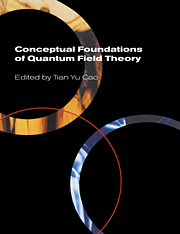Book contents
- Frontmatter
- Contents
- List of contributors
- Preface
- Photographs of the conference
- Introduction: Conceptual issues in quantum field theory
- Part One Philosophers' interest in quantum field theory
- Part Two Three approaches to the foundations of quantum field theory
- Part Three
- Part Four Mathematics, statistics and quantum field theory
- 8 Renormalization group theory: its basis and formulation in statistical physics
- 9 Where does quantum field theory fit into the big picture?
- 10 The unreasonable effectiveness of quantum field theory
- 11 Comments: The quantum field theory of physics and of mathematics
- Part Five Quantum field theory and space-time
- Part Six
- Part Seven Renormalization group
- Part Eight Non-Abelian gauge theory
- Part Nine The ontology of particles or fields
- Part Ten
- Name index
- Subject index
11 - Comments: The quantum field theory of physics and of mathematics
Published online by Cambridge University Press: 22 September 2009
- Frontmatter
- Contents
- List of contributors
- Preface
- Photographs of the conference
- Introduction: Conceptual issues in quantum field theory
- Part One Philosophers' interest in quantum field theory
- Part Two Three approaches to the foundations of quantum field theory
- Part Three
- Part Four Mathematics, statistics and quantum field theory
- 8 Renormalization group theory: its basis and formulation in statistical physics
- 9 Where does quantum field theory fit into the big picture?
- 10 The unreasonable effectiveness of quantum field theory
- 11 Comments: The quantum field theory of physics and of mathematics
- Part Five Quantum field theory and space-time
- Part Six
- Part Seven Renormalization group
- Part Eight Non-Abelian gauge theory
- Part Nine The ontology of particles or fields
- Part Ten
- Name index
- Subject index
Summary
One recognizes that there has been, and continues to be, a great deal of common ground between statistical mechanics and quantum field theory (QFT). Many of the effects and methods of statistical physics find parallels in QFT, particularly in the application of the latter to particle physics. One encounters spontaneous symmetry breaking, renormalization group, solitons, effective field theories, fractional charge, and many other shared phenomena.
Professor Fisher [1] has given us a wonderful overview of the discovery and role of the renormalization group (RG) in statistical physics. He also touched on some of the similarities and differences in the foundations of the RG in condensed matter and high-energy physics, which were amplified in the discussion. In the latter subject, in addition to the formulation requiring cutoff-independence, we have the very fruitful Callan-Symanzik equations. That is, in the process of renormalizing the divergences of QFT, arbitrary, finite mass-scales appear in the renormalized amplitudes. The Callan-Symanzik equations are the consequence of the requirement that the renormalized amplitudes in fact be independent of these arbitrary masses. This point of view is particularly useful in particle physics, although it does make its appearance in condensed matter physics as well.
The very beautiful subject of conformal field theory spans all three topics we are considering: critical phenomena, quantum field theory, and mathematics. The relationship between conformal field theory and two-dimensional critical phenomena has become particularly fruitful in recent years.
- Type
- Chapter
- Information
- Conceptual Foundations of Quantum Field Theory , pp. 161 - 165Publisher: Cambridge University PressPrint publication year: 1999



